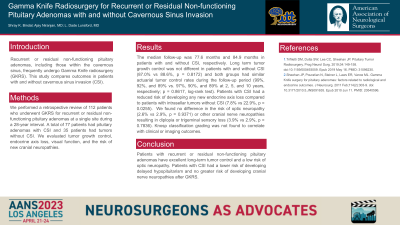Gamma Knife Radiosurgery for Recurrent or Residual Non-functioning Pituitary Adenomas with and without Cavernous Sinus Invasion
Gamma Knife Radiosurgery for Recurrent or Residual Non-functioning Pituitary Adenomas with and Without Cavernous Sinus Invasion
Friday, April 21, 2023


Shray K. Bindal, BA
Medical Student
University of Pittsburgh School of Medicine
Sugar Land, Texas, United States
ePoster Presenter(s)
Introduction: Recurrent or residual non-functioning pituitary adenomas, including those within the cavernous sinus, frequently undergo Gamma Knife radiosurgery (GKRS). This study compares outcomes in patients with and without cavernous sinus invasion (CSI).
Methods: We performed a retrospective review of 112 patients who underwent GKRS for recurrent or residual non-functioning pituitary adenomas at a single site during a 28-year interval. A total of 77 patients had pituitary adenomas with CSI and 35 patients had tumors without CSI. We evaluated tumor growth control, endocrine axis loss, visual function, and the risk of new cranial neuropathies.
Results: The median follow-up was 77.6 months and 84.9 months in patients with and without CSI, respectively. Long term tumor growth control was not different in patients with and without CSI (87.0% vs 88.6%, p = 0.8172) and both groups had similar actuarial tumor control rates during the follow-up period (99%, 92%, and 89% vs. 97%, 90%, and 89% at 2, 5, and 10 years, respectively; p = 0.8617, log-rank test). Patients with CSI had a reduced risk of developing any new endocrine axis loss compared to patients with intrasellar tumors without CSI (7.8% vs 22.9%, p = 0.0255). We found no difference in the risk of optic neuropathy (2.6% vs 2.9%, p = 0.9371) or other cranial nerve neuropathies resulting in diplopia or trigeminal sensory loss (3.9% vs 2.9%, p = 0.7836). Knosp classification grading was not found to correlate with clinical or imaging outcomes.
Conclusion : Patients with recurrent or residual non-functioning pituitary adenomas have excellent long-term tumor control and a low risk of optic neuropathy. Patients with CSI had a lower risk of developing delayed hypopituitarism and no greater risk of developing cranial nerve neuropathies after GKRS.
Methods: We performed a retrospective review of 112 patients who underwent GKRS for recurrent or residual non-functioning pituitary adenomas at a single site during a 28-year interval. A total of 77 patients had pituitary adenomas with CSI and 35 patients had tumors without CSI. We evaluated tumor growth control, endocrine axis loss, visual function, and the risk of new cranial neuropathies.
Results: The median follow-up was 77.6 months and 84.9 months in patients with and without CSI, respectively. Long term tumor growth control was not different in patients with and without CSI (87.0% vs 88.6%, p = 0.8172) and both groups had similar actuarial tumor control rates during the follow-up period (99%, 92%, and 89% vs. 97%, 90%, and 89% at 2, 5, and 10 years, respectively; p = 0.8617, log-rank test). Patients with CSI had a reduced risk of developing any new endocrine axis loss compared to patients with intrasellar tumors without CSI (7.8% vs 22.9%, p = 0.0255). We found no difference in the risk of optic neuropathy (2.6% vs 2.9%, p = 0.9371) or other cranial nerve neuropathies resulting in diplopia or trigeminal sensory loss (3.9% vs 2.9%, p = 0.7836). Knosp classification grading was not found to correlate with clinical or imaging outcomes.
Conclusion : Patients with recurrent or residual non-functioning pituitary adenomas have excellent long-term tumor control and a low risk of optic neuropathy. Patients with CSI had a lower risk of developing delayed hypopituitarism and no greater risk of developing cranial nerve neuropathies after GKRS.
